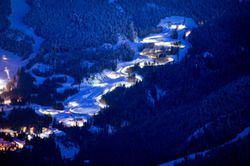Whistler (pps/November 3, 2009) Referring to the future Olympic track at the “Whistler Sliding Park”, the most successful luger of all times goes as far as proclaiming a new era. “This track is faster than anything we’ve experienced so far in the sport of luge. This track will pose new challenges for athletes and sleds”, explained Germany’s Georg Hackl, decorated with three Olympic gold and two silver medals.
The raw data of the track: construction costs of 105 million Canadian dollars (amounting to the equivalent of 68 million Euro); length of the track from the start in the men’s singles: 1,374 metres, featuring 16 turns (women’s singles: 1,198 metres and 14 turns).
The rather awesome names of the different track sections, however, make it all come alive. “Thunderbird” or “Shiver”, for instance, are the names of two turns while others are named after animals, Lynx, for example, or they evoke notable events. “Lueders Loop” for instance is the name of turn number seven in honour of Canada’s Pierre Lueders, 1998 Olympic bobsleigh champion in the two-man, after he crashed out his sled just like a corkscrew during the track’s homologation in March 2008.
Only those athletes, who will master the combination of turns 12, 13, 14 and 15 – the so-called “Gold Rush Trial” – without the slightest error might successfully start “digging for luge gold” at the Olympic Winter Games in Vancouver next year (February 12-28, 2010).
“You can’t let your guard down on this track. Never.” This is how World champion Erin Hamlin (USA) describes the track situated in the “Blackcomb Mountains”. And Hamlin continues: “I like the challenge. This track offers a bit of everything, but most of all what I like best: Speed.”
And in the meantime this speed has officially been certified – at the Luge World Cup final in February 2009, the track has made it into the history books. At that time, two-time World champion Felix Loch of Germany set up a new luge World record, clocking 153,98 km/h. Thus, he replaced the old record of the 1989, 1990 and 1997 World champion Georg Hackl of Germany. At the 34th FIL World Luge Championships in St. Moritz (Switzerland) in 2000 Hackl had achieved 144,3 km/h.
“All they ever talk about is the lower part. And rightly so because of the great speed. But they forget that the upper section already represents a great challenge,” said Erin Hamlin. According to the World champion, the first turns of the track have to be mastered gently in order not to lose too much time. “Otherwise you can never catch up again.”










